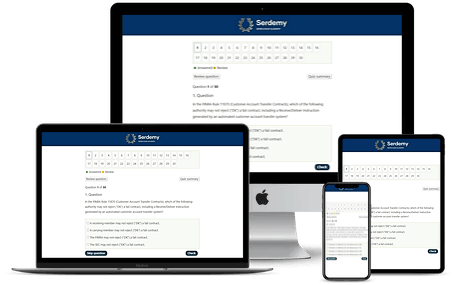Quiz-summary
0 of 30 questions completed
Questions:
- 1
- 2
- 3
- 4
- 5
- 6
- 7
- 8
- 9
- 10
- 11
- 12
- 13
- 14
- 15
- 16
- 17
- 18
- 19
- 20
- 21
- 22
- 23
- 24
- 25
- 26
- 27
- 28
- 29
- 30
Information
Premium Practice Questions
You have already completed the quiz before. Hence you can not start it again.
Quiz is loading...
You must sign in or sign up to start the quiz.
You have to finish following quiz, to start this quiz:
Results
0 of 30 questions answered correctly
Your time:
Time has elapsed
Categories
- Not categorized 0%
- 1
- 2
- 3
- 4
- 5
- 6
- 7
- 8
- 9
- 10
- 11
- 12
- 13
- 14
- 15
- 16
- 17
- 18
- 19
- 20
- 21
- 22
- 23
- 24
- 25
- 26
- 27
- 28
- 29
- 30
- Answered
- Review
-
Question 1 of 30
1. Question
Momentum Alpha Advisors, a registered Commodity Trading Advisor (CTA), manages a publicly offered futures trading program that has been operating for four years. The firm’s principal, Kai, also manages a small, private fund for qualified eligible persons using a similar, but more aggressive, trading strategy. Over the last 12 months, the private fund achieved exceptionally high returns, while the public program’s returns were modest. In an effort to attract new clients to the public program, Kai directs his marketing team to update the CTA’s disclosure document to prominently feature the private fund’s spectacular 12-month performance record alongside the public program’s complete four-year history. Which of the following best assesses the regulatory compliance of this proposed action under NFA rules?
Correct
The core regulatory issue stems from NFA Compliance Rule 2-29, which governs communications with the public and promotional material, and CFTC Regulation 4.35, which details the requirements for presenting performance in disclosure documents. The proposed action by the Commodity Trading Advisor (CTA) involves presenting performance from a “related account”—the private fund—in the disclosure document for its main public trading program. While NFA rules do not outright prohibit the use of related account performance, they impose strict conditions to ensure the presentation is fair, balanced, and not misleading. The primary violation is the selective presentation of data. The CTA wishes to include only the most recent, highly successful one-year performance of the related account. This practice, often called “cherry-picking,” creates a misleading impression of the potential returns and risks of the offered program. NFA guidance requires that if a CTA presents the performance of a related account, it must be presented with equal or greater prominence than the offered program’s performance and must cover the same time period, or the entire operational history of the related account up to five years. By presenting only a single, favorable year, the CTA fails to provide the full context, which might include periods of average or poor performance. This lack of balance violates the fundamental principle that all communications must be based on principles of fair dealing and good faith and provide a sound basis for evaluating the facts. The material must also clearly disclose that the results are from a related account and may not be indicative of the results of the offered program.
Incorrect
The core regulatory issue stems from NFA Compliance Rule 2-29, which governs communications with the public and promotional material, and CFTC Regulation 4.35, which details the requirements for presenting performance in disclosure documents. The proposed action by the Commodity Trading Advisor (CTA) involves presenting performance from a “related account”—the private fund—in the disclosure document for its main public trading program. While NFA rules do not outright prohibit the use of related account performance, they impose strict conditions to ensure the presentation is fair, balanced, and not misleading. The primary violation is the selective presentation of data. The CTA wishes to include only the most recent, highly successful one-year performance of the related account. This practice, often called “cherry-picking,” creates a misleading impression of the potential returns and risks of the offered program. NFA guidance requires that if a CTA presents the performance of a related account, it must be presented with equal or greater prominence than the offered program’s performance and must cover the same time period, or the entire operational history of the related account up to five years. By presenting only a single, favorable year, the CTA fails to provide the full context, which might include periods of average or poor performance. This lack of balance violates the fundamental principle that all communications must be based on principles of fair dealing and good faith and provide a sound basis for evaluating the facts. The material must also clearly disclose that the results are from a related account and may not be indicative of the results of the offered program.
-
Question 2 of 30
2. Question
Assessment of a private fund’s operations reveals the following: The fund, managed by Kenji, has a liquidation value of $10 million and exclusively serves 25 accredited investors. Kenji maintains a publicly accessible website that details the fund’s investment strategy and includes a contact form for “interested accredited investors.” The fund’s commodity interest trading activity involves committing $600,000 as initial margin for futures positions, and the aggregate net notional value of these positions is $8 million. Based on these facts, what is Kenji’s registration requirement under CFTC regulations?
Correct
The correct determination is that the fund manager must register as a Commodity Pool Operator (CPO). This conclusion is based on an analysis of the exemption requirements under CFTC Regulation 4.13(a)(3), often referred to as the de minimis exemption. To qualify for this exemption, a CPO must satisfy several concurrent conditions. First, the pool must be offered and sold without marketing to the public in the United States. Second, all participants must be accredited investors, knowledgeable employees, or non-U.S. persons. Third, the pool must meet one of two trading thresholds. The first threshold is that the aggregate initial margin and premiums required to establish commodity interest positions do not exceed 5 percent of the liquidation value of the pool’s portfolio. The alternative threshold is that the aggregate net notional value of such positions does not exceed 100 percent of the liquidation value of the pool’s portfolio. In this scenario, the fund has a liquidation value of $10 million and has committed $600,000 to initial margin. The percentage of the portfolio used for margin is calculated as \(\frac{\$600,000}{\$10,000,000}\), which equals 6%. Since 6% is greater than the 5% limit, the fund fails to meet the first trading threshold. However, the fund does meet the alternative threshold, as its net notional value of $8 million is 80% of the liquidation value, which is below the 100% limit. While the fund satisfies the participant qualification requirement (all are accredited investors) and one of the trading thresholds, it fails a critical condition: the prohibition on marketing to the public. A publicly accessible website that describes the fund and provides a method for interested parties to inquire is generally considered a form of public marketing or general solicitation. Because all conditions for the exemption must be met simultaneously, the failure of even one condition, in this case the marketing prohibition, disqualifies the fund from the exemption. Therefore, the manager is required to register as a CPO with the CFTC and become an NFA member.
Incorrect
The correct determination is that the fund manager must register as a Commodity Pool Operator (CPO). This conclusion is based on an analysis of the exemption requirements under CFTC Regulation 4.13(a)(3), often referred to as the de minimis exemption. To qualify for this exemption, a CPO must satisfy several concurrent conditions. First, the pool must be offered and sold without marketing to the public in the United States. Second, all participants must be accredited investors, knowledgeable employees, or non-U.S. persons. Third, the pool must meet one of two trading thresholds. The first threshold is that the aggregate initial margin and premiums required to establish commodity interest positions do not exceed 5 percent of the liquidation value of the pool’s portfolio. The alternative threshold is that the aggregate net notional value of such positions does not exceed 100 percent of the liquidation value of the pool’s portfolio. In this scenario, the fund has a liquidation value of $10 million and has committed $600,000 to initial margin. The percentage of the portfolio used for margin is calculated as \(\frac{\$600,000}{\$10,000,000}\), which equals 6%. Since 6% is greater than the 5% limit, the fund fails to meet the first trading threshold. However, the fund does meet the alternative threshold, as its net notional value of $8 million is 80% of the liquidation value, which is below the 100% limit. While the fund satisfies the participant qualification requirement (all are accredited investors) and one of the trading thresholds, it fails a critical condition: the prohibition on marketing to the public. A publicly accessible website that describes the fund and provides a method for interested parties to inquire is generally considered a form of public marketing or general solicitation. Because all conditions for the exemption must be met simultaneously, the failure of even one condition, in this case the marketing prohibition, disqualifies the fund from the exemption. Therefore, the manager is required to register as a CPO with the CFTC and become an NFA member.
-
Question 3 of 30
3. Question
An assessment of a private fund, “Helios Quantitative Strategies LP,” reveals the following: The fund is managed by its sole general partner, Priya, who is not registered as a CPO. The fund has 14 participants, all of whom are U.S. persons. Twelve of these participants are accredited investors as defined by the SEC, but two are financially sophisticated individuals who do not meet the accredited investor criteria. The fund’s portfolio consists primarily of equities, but it allocates a small portion of its assets to commodity futures contracts, such that the aggregate initial margin for these positions has consistently remained at 4% of the pool’s liquidation value. The fund is not marketed to the public as a commodity pool. Priya has filed a notice of exemption from CPO registration with the NFA, believing she qualifies for the de minimis exemption. Based on these facts, what is Priya’s regulatory status?
Correct
The analysis centers on the requirements for exemption from Commodity Pool Operator (CPO) registration under CFTC Rule 4.13(a)(3), often referred to as the “de minimis” exemption. To qualify for this exemption, a person must meet several strict conditions simultaneously. First, the pool’s commodity interest positions must be limited, meaning either the aggregate initial margin and premiums for such positions do not exceed 5 percent of the liquidation value of the pool’s portfolio, or the aggregate net notional value of the positions does not exceed 100 percent of the pool’s liquidation value. Second, the pool cannot be marketed as a vehicle for trading in the commodity futures or options markets. Third, the person must file a notice of exemption with the NFA. Crucially, the fourth condition pertains to the composition of the pool’s participants. All participants in the pool must be limited to a specific list of qualified persons, which includes accredited investors as defined in SEC Rule 501(a), knowledgeable employees, and certain non-U.S. persons. The rule does not provide for a general category of “sophisticated” but non-accredited U.S. investors. In the given scenario, the fund has two participants who are not accredited investors. The presence of even a single non-qualified participant, such as a non-accredited U.S. investor who is not a knowledgeable employee, disqualifies the operator from using the 4.13(a)(3) exemption. Therefore, regardless of whether the other conditions concerning trading thresholds and marketing are met, the operator is required to register as a CPO with the CFTC and become an NFA member because the participant criteria are not satisfied.
Incorrect
The analysis centers on the requirements for exemption from Commodity Pool Operator (CPO) registration under CFTC Rule 4.13(a)(3), often referred to as the “de minimis” exemption. To qualify for this exemption, a person must meet several strict conditions simultaneously. First, the pool’s commodity interest positions must be limited, meaning either the aggregate initial margin and premiums for such positions do not exceed 5 percent of the liquidation value of the pool’s portfolio, or the aggregate net notional value of the positions does not exceed 100 percent of the pool’s liquidation value. Second, the pool cannot be marketed as a vehicle for trading in the commodity futures or options markets. Third, the person must file a notice of exemption with the NFA. Crucially, the fourth condition pertains to the composition of the pool’s participants. All participants in the pool must be limited to a specific list of qualified persons, which includes accredited investors as defined in SEC Rule 501(a), knowledgeable employees, and certain non-U.S. persons. The rule does not provide for a general category of “sophisticated” but non-accredited U.S. investors. In the given scenario, the fund has two participants who are not accredited investors. The presence of even a single non-qualified participant, such as a non-accredited U.S. investor who is not a knowledgeable employee, disqualifies the operator from using the 4.13(a)(3) exemption. Therefore, regardless of whether the other conditions concerning trading thresholds and marketing are met, the operator is required to register as a CPO with the CFTC and become an NFA member because the participant criteria are not satisfied.
-
Question 4 of 30
4. Question
An assessment of a new Commodity Trading Advisor’s (CTA) proposed marketing materials reveals a potential compliance issue. The CTA, “Momentum Futures Advisors,” is operated by a sole principal, Kenji. Kenji has a personal futures trading account that has generated significant returns over the last 24 months using a specific trend-following strategy. The CTA’s new brochure prominently features these returns under the headline, “A Proven 24-Month Track Record with Our Proprietary Strategy.” The brochure makes no mention that these results were achieved in Kenji’s personal account and not by managing client funds under the CTA’s advisory program. Under NFA Compliance Rule 2-29, which statement most accurately describes the compliance status of this promotional material?
Correct
NFA Compliance Rule 2-29 governs communications with the public and promotional material. A core principle of this rule is that all communications must be based on principles of fair dealing and good faith and are prohibited from being deceptive or misleading. When a Commodity Trading Advisor (CTA) presents performance records, these records are subject to stringent requirements to ensure they are not misleading. In the scenario where a CTA wishes to use the performance of a principal’s proprietary or personal trading account, specific conditions must be met. It is considered misleading to present proprietary trading results as the actual performance of the CTA’s client program. The performance of the program being offered to clients is considered to begin only when client funds are first managed using that program. While a principal’s past performance can be used to demonstrate their experience, it cannot be presented as the track record of the program itself. If such proprietary performance is shown, it must be clearly and prominently disclosed that the results are from a proprietary account, not a client account. Furthermore, the CTA must disclose any material differences between the conditions under which the proprietary account was traded and the conditions under which client accounts will be traded. These differences can include the impact of fees, asset size, liquidity constraints, and execution efficiency. Simply stating that the strategy is the same is insufficient. Failing to provide these critical disclosures and presenting the proprietary record as the firm’s program record constitutes a serious violation of NFA Rule 2-29.
Incorrect
NFA Compliance Rule 2-29 governs communications with the public and promotional material. A core principle of this rule is that all communications must be based on principles of fair dealing and good faith and are prohibited from being deceptive or misleading. When a Commodity Trading Advisor (CTA) presents performance records, these records are subject to stringent requirements to ensure they are not misleading. In the scenario where a CTA wishes to use the performance of a principal’s proprietary or personal trading account, specific conditions must be met. It is considered misleading to present proprietary trading results as the actual performance of the CTA’s client program. The performance of the program being offered to clients is considered to begin only when client funds are first managed using that program. While a principal’s past performance can be used to demonstrate their experience, it cannot be presented as the track record of the program itself. If such proprietary performance is shown, it must be clearly and prominently disclosed that the results are from a proprietary account, not a client account. Furthermore, the CTA must disclose any material differences between the conditions under which the proprietary account was traded and the conditions under which client accounts will be traded. These differences can include the impact of fees, asset size, liquidity constraints, and execution efficiency. Simply stating that the strategy is the same is insufficient. Failing to provide these critical disclosures and presenting the proprietary record as the firm’s program record constitutes a serious violation of NFA Rule 2-29.
-
Question 5 of 30
5. Question
An assessment of a new promotional brochure for “Quantum Leap Advisors,” a registered Commodity Trading Advisor (CTA), reveals the following. The main headline of the brochure, in a large 48-point font, states: “ACHIEVED A 35% GROSS RETURN LAST YEAR!” A small footnote at the bottom of the page, in a 6-point font, discloses: “Net performance after a 2% management fee and 20% incentive fee was 26%. Past performance is not necessarily indicative of future results. Trading futures involves substantial risk of loss.” Based on NFA Compliance Rule 2-29, which statement best identifies the primary compliance failure in this promotional material?
Correct
The core issue is the presentation of performance data in promotional material under NFA Compliance Rule 2-29. This rule mandates that all communications with the public must be based on principles of fair dealing and good faith and should not be misleading. When a Commodity Trading Advisor (CTA) includes performance information in its promotional materials, it must be presented in a balanced and fair manner. A critical requirement of this rule is that if the material shows gross trading profits or performance, the net, after-fee performance must also be displayed with equal or greater prominence. In this scenario, the CTA prominently displays a high gross return figure in a large, bold font. However, the actual performance a client would have realized, which is the net performance after deducting management fees, incentive fees, and brokerage commissions, is relegated to a small-print footnote. This method of presentation is explicitly prohibited because it creates a misleading impression of the potential returns. The prominent gross figure is likely to catch the reader’s eye, while the more realistic net figure is easily overlooked. The NFA’s “equal or greater prominence” standard ensures that potential clients receive a clear and realistic picture of the CTA’s performance, preventing them from making decisions based on inflated or incomplete information.
Incorrect
The core issue is the presentation of performance data in promotional material under NFA Compliance Rule 2-29. This rule mandates that all communications with the public must be based on principles of fair dealing and good faith and should not be misleading. When a Commodity Trading Advisor (CTA) includes performance information in its promotional materials, it must be presented in a balanced and fair manner. A critical requirement of this rule is that if the material shows gross trading profits or performance, the net, after-fee performance must also be displayed with equal or greater prominence. In this scenario, the CTA prominently displays a high gross return figure in a large, bold font. However, the actual performance a client would have realized, which is the net performance after deducting management fees, incentive fees, and brokerage commissions, is relegated to a small-print footnote. This method of presentation is explicitly prohibited because it creates a misleading impression of the potential returns. The prominent gross figure is likely to catch the reader’s eye, while the more realistic net figure is easily overlooked. The NFA’s “equal or greater prominence” standard ensures that potential clients receive a clear and realistic picture of the CTA’s performance, preventing them from making decisions based on inflated or incomplete information.
-
Question 6 of 30
6. Question
Kenji operates a wealth management firm as a registered investment adviser (RIA), focusing on equity and fixed-income securities for his clients. For 12 of his long-standing clients, he develops and actively manages a distinct and separate futures trading strategy that is designed to generate absolute returns, independent of the performance of their securities portfolios. He does not charge a separate advisory fee for this futures strategy, and he has never advertised or otherwise held himself out to the public as a provider of futures advice. Considering the CFTC’s registration requirements, why would Kenji most likely be required to register as a Commodity Trading Advisor (CTA)?
Correct
The analysis hinges on the requirements for exemption from registration as a Commodity Trading Advisor (CTA) under CFTC Rule 4.14(a)(8). This rule provides a de minimis exemption for certain individuals. To qualify, the person must meet several conditions concurrently. First, their commodity interest trading advice must be solely incidental to their primary business or profession. Second, they must not hold themselves out to the public as a CTA. Third, they must have provided trading advice to no more than 15 persons during the preceding 12 months. In this scenario, Kenji is a registered investment adviser (RIA) whose primary business is managing securities. He provides futures advice to only 12 clients, which is under the 15-person threshold. He also does not advertise or hold himself out as a CTA. However, the critical failure point is the “solely incidental” test. The advice is not considered solely incidental when it involves creating a distinct, standalone, alpha-generating futures trading strategy. Incidental advice is typically general, non-specific, and directly related to the management of the primary securities portfolio, such as using futures to hedge a stock portfolio. Developing a separate, active trading program, even for a small number of clients and without a separate fee, elevates the activity beyond the scope of being merely incidental. Therefore, because the futures strategy is a principal and distinct service rather than a subordinate component of his securities advisory business, Kenji would be required to register as a CTA with the CFTC and become a member of the NFA.
Incorrect
The analysis hinges on the requirements for exemption from registration as a Commodity Trading Advisor (CTA) under CFTC Rule 4.14(a)(8). This rule provides a de minimis exemption for certain individuals. To qualify, the person must meet several conditions concurrently. First, their commodity interest trading advice must be solely incidental to their primary business or profession. Second, they must not hold themselves out to the public as a CTA. Third, they must have provided trading advice to no more than 15 persons during the preceding 12 months. In this scenario, Kenji is a registered investment adviser (RIA) whose primary business is managing securities. He provides futures advice to only 12 clients, which is under the 15-person threshold. He also does not advertise or hold himself out as a CTA. However, the critical failure point is the “solely incidental” test. The advice is not considered solely incidental when it involves creating a distinct, standalone, alpha-generating futures trading strategy. Incidental advice is typically general, non-specific, and directly related to the management of the primary securities portfolio, such as using futures to hedge a stock portfolio. Developing a separate, active trading program, even for a small number of clients and without a separate fee, elevates the activity beyond the scope of being merely incidental. Therefore, because the futures strategy is a principal and distinct service rather than a subordinate component of his securities advisory business, Kenji would be required to register as a CTA with the CFTC and become a member of the NFA.
-
Question 7 of 30
7. Question
Momentum Alpha Strategies, a registered Commodity Trading Advisor (CTA) operating for five years, received a prestigious “Top Performer” award from an independent industry analytics firm. The award was based solely on the CTA’s risk-adjusted returns over the most recent three-year period. The CTA now intends to prominently feature this award in its promotional materials targeted at prospective clients. To ensure compliance with NFA rules, what is the most critical set of actions Momentum Alpha must take regarding the presentation of this award and its performance history?
Correct
The correct course of action is that the CTA must present its complete five-year performance history, disclose that the third-party rating is not indicative of any single client’s experience and is not a guarantee of future performance or success, and must also ensure that the criteria used by the third-party firm to grant the award are made available to the public. NFA Compliance Rule 2-29 governs communications with the public and promotional material. While the use of third-party reports or testimonials is not outright banned, it is subject to very strict guidelines to prevent misleading potential customers. When a member, such as a CTA, uses a third-party rating or award, it cannot be presented in a way that is deceptive or implies a level of expertise or success that is not warranted. The NFA requires specific disclaimers to accompany such material. The member must disclose that the report or rating may not be representative of a particular client’s experience and is not a guarantee of future results. Furthermore, the member must be able to provide details about the criteria used to create the rating. Crucially, using a third-party report that covers a specific, favorable period does not absolve the CTA of its separate obligation to present its full, required performance history. In this scenario, the CTA has been operating for five years, so its complete performance record for that entire period must be included in the promotional material, not just the three-year period that the award was based on. This prevents the CTA from “cherry-picking” a favorable timeframe and ensures clients receive a comprehensive and balanced view of the CTA’s entire operational history.
Incorrect
The correct course of action is that the CTA must present its complete five-year performance history, disclose that the third-party rating is not indicative of any single client’s experience and is not a guarantee of future performance or success, and must also ensure that the criteria used by the third-party firm to grant the award are made available to the public. NFA Compliance Rule 2-29 governs communications with the public and promotional material. While the use of third-party reports or testimonials is not outright banned, it is subject to very strict guidelines to prevent misleading potential customers. When a member, such as a CTA, uses a third-party rating or award, it cannot be presented in a way that is deceptive or implies a level of expertise or success that is not warranted. The NFA requires specific disclaimers to accompany such material. The member must disclose that the report or rating may not be representative of a particular client’s experience and is not a guarantee of future results. Furthermore, the member must be able to provide details about the criteria used to create the rating. Crucially, using a third-party report that covers a specific, favorable period does not absolve the CTA of its separate obligation to present its full, required performance history. In this scenario, the CTA has been operating for five years, so its complete performance record for that entire period must be included in the promotional material, not just the three-year period that the award was based on. This prevents the CTA from “cherry-picking” a favorable timeframe and ensures clients receive a comprehensive and balanced view of the CTA’s entire operational history.
-
Question 8 of 30
8. Question
Apex Futures Strategies, a registered Commodity Trading Advisor (CTA), manages two trading programs: the “Global Macro Program,” which has a five-year track record of consistent profitability, and the “Quantitative Momentum Program,” which has incurred modest losses over the same five-year period. In developing a new marketing campaign, the firm’s principal proposes creating a brochure that prominently features the complete five-year performance history of only the Global Macro Program. The brochure would also contain the required NFA verbatim risk disclosure statement but would make no mention of the existence or performance of the Quantitative Momentum Program. An analysis of this proposal under NFA Compliance Rule 2-29 would find that:
Correct
Logical Deduction to Final Answer: Step 1: Identify the governing regulation. The creation and distribution of marketing materials by a Commodity Trading Advisor (CTA) are governed by NFA Compliance Rule 2-29, “Communications with the Public and Promotional Material.” Step 2: Analyze the scenario. Apex Futures Strategies, a registered CTA, manages two distinct trading programs: the “Global Macro Program” and the “Quantitative Momentum Program.” The firm proposes to create promotional material that exclusively highlights the successful performance of the Global Macro Program, while completely omitting any mention or performance data of the less successful Quantitative Momentum Program. Step 3: Apply the specific provisions of NFA Compliance Rule 2-29 regarding performance reporting. This rule mandates that all communications must be balanced and fair. It explicitly prohibits “cherry-picking” successful results. When a CTA offers more than one program, promotional material that presents performance results must not be limited to the best-performing programs. If a CTA chooses to present the performance of a subset of its programs, it must disclose that the firm offers other programs and that the results for these other programs may be materially different. Step 4: Determine the compliance status. By showcasing only the successful program and omitting the underperforming one without the required disclosures, Apex is creating a misleading impression of its overall management skill and performance history. This selective presentation violates the core principle of providing balanced information and directly contravenes the NFA’s specific guidance on presenting performance records for multiple programs. The inclusion of a generic risk disclosure statement does not rectify this specific violation. Step 5: Conclude the finding. The proposed promotional material is non-compliant with NFA Rule 2-29 because it selectively presents favorable performance data, thereby failing to provide a fair and balanced view of the CTA’s complete track record. NFA Compliance Rule 2-29 establishes the standards for all communications with the public by NFA Members to prevent fraudulent or misleading statements. A core tenet of this rule is that all promotional material must be balanced and may not omit any material facts if the omission would make the communication misleading. When a Commodity Trading Advisor or Commodity Pool Operator presents performance records, there are specific requirements to ensure fairness. The practice of “cherry-picking,” or selectively displaying only the best-performing accounts or programs, is strictly prohibited. If a CTA like Apex Futures Strategies offers multiple trading programs, it cannot create marketing material that highlights only the most successful one while ignoring others. Doing so would present a skewed and misleading picture of the CTA’s overall ability and historical performance. To be compliant, if a CTA presents the results of one program, it must do so in a manner that is not misleading and typically must include disclosures indicating that other programs are available and their performance may have been materially different. Simply including the standard verbatim risk disclosure does not cure a violation related to the misleading presentation of performance data.
Incorrect
Logical Deduction to Final Answer: Step 1: Identify the governing regulation. The creation and distribution of marketing materials by a Commodity Trading Advisor (CTA) are governed by NFA Compliance Rule 2-29, “Communications with the Public and Promotional Material.” Step 2: Analyze the scenario. Apex Futures Strategies, a registered CTA, manages two distinct trading programs: the “Global Macro Program” and the “Quantitative Momentum Program.” The firm proposes to create promotional material that exclusively highlights the successful performance of the Global Macro Program, while completely omitting any mention or performance data of the less successful Quantitative Momentum Program. Step 3: Apply the specific provisions of NFA Compliance Rule 2-29 regarding performance reporting. This rule mandates that all communications must be balanced and fair. It explicitly prohibits “cherry-picking” successful results. When a CTA offers more than one program, promotional material that presents performance results must not be limited to the best-performing programs. If a CTA chooses to present the performance of a subset of its programs, it must disclose that the firm offers other programs and that the results for these other programs may be materially different. Step 4: Determine the compliance status. By showcasing only the successful program and omitting the underperforming one without the required disclosures, Apex is creating a misleading impression of its overall management skill and performance history. This selective presentation violates the core principle of providing balanced information and directly contravenes the NFA’s specific guidance on presenting performance records for multiple programs. The inclusion of a generic risk disclosure statement does not rectify this specific violation. Step 5: Conclude the finding. The proposed promotional material is non-compliant with NFA Rule 2-29 because it selectively presents favorable performance data, thereby failing to provide a fair and balanced view of the CTA’s complete track record. NFA Compliance Rule 2-29 establishes the standards for all communications with the public by NFA Members to prevent fraudulent or misleading statements. A core tenet of this rule is that all promotional material must be balanced and may not omit any material facts if the omission would make the communication misleading. When a Commodity Trading Advisor or Commodity Pool Operator presents performance records, there are specific requirements to ensure fairness. The practice of “cherry-picking,” or selectively displaying only the best-performing accounts or programs, is strictly prohibited. If a CTA like Apex Futures Strategies offers multiple trading programs, it cannot create marketing material that highlights only the most successful one while ignoring others. Doing so would present a skewed and misleading picture of the CTA’s overall ability and historical performance. To be compliant, if a CTA presents the results of one program, it must do so in a manner that is not misleading and typically must include disclosures indicating that other programs are available and their performance may have been materially different. Simply including the standard verbatim risk disclosure does not cure a violation related to the misleading presentation of performance data.
-
Question 9 of 30
9. Question
An evaluation of Kenji’s investment fund, Momentum Alpha Partners, is being conducted to determine its CPO registration requirements under CFTC regulations. The fund has $50 million in assets and its participants are all verified accredited investors. Which set of circumstances most accurately describes the conditions under which Kenji can claim an exemption from CPO registration pursuant to CFTC Regulation 4.13(a)(3)?
Correct
The calculation to determine if the trading threshold is met is as follows. The total liquidation value of the pool’s portfolio is $50,000,000. The aggregate initial margin and premiums required to establish its commodity interest positions is $2,000,000. The percentage of the portfolio’s liquidation value used for these positions is calculated by dividing the margin and premiums by the total liquidation value: $2,000,000 / $50,000,000 = 0.04, or 4%. Under the Commodity Exchange Act, a Commodity Pool Operator (CPO) is generally required to register with the CFTC and become a member of the NFA. However, CFTC Regulation 4.13 provides for certain exemptions from registration. Specifically, Regulation 4.13(a)(3), often referred to as the “de minimis” exemption, is available to a CPO if several strict conditions are met. First, the pool’s commodity interest trading must be limited. This is satisfied if either the aggregate initial margin and premiums for the pool’s commodity interest positions do not exceed 5 percent of the liquidation value of the pool’s portfolio, or the aggregate net notional value of its commodity interest positions does not exceed 100 percent of the liquidation value of the portfolio. In this case, the 4% level is below the 5% threshold, satisfying this condition. Second, the pool cannot be marketed as a vehicle for trading in commodity futures or options markets. Third, interests in the pool must be offered privately and not to the general public. Finally, participation in the pool is restricted to specific categories of sophisticated investors, such as accredited investors or qualified eligible persons. The combination of meeting the limited trading threshold, private offering structure, appropriate marketing, and having only accredited investors as participants allows the CPO to claim this exemption.
Incorrect
The calculation to determine if the trading threshold is met is as follows. The total liquidation value of the pool’s portfolio is $50,000,000. The aggregate initial margin and premiums required to establish its commodity interest positions is $2,000,000. The percentage of the portfolio’s liquidation value used for these positions is calculated by dividing the margin and premiums by the total liquidation value: $2,000,000 / $50,000,000 = 0.04, or 4%. Under the Commodity Exchange Act, a Commodity Pool Operator (CPO) is generally required to register with the CFTC and become a member of the NFA. However, CFTC Regulation 4.13 provides for certain exemptions from registration. Specifically, Regulation 4.13(a)(3), often referred to as the “de minimis” exemption, is available to a CPO if several strict conditions are met. First, the pool’s commodity interest trading must be limited. This is satisfied if either the aggregate initial margin and premiums for the pool’s commodity interest positions do not exceed 5 percent of the liquidation value of the pool’s portfolio, or the aggregate net notional value of its commodity interest positions does not exceed 100 percent of the liquidation value of the portfolio. In this case, the 4% level is below the 5% threshold, satisfying this condition. Second, the pool cannot be marketed as a vehicle for trading in commodity futures or options markets. Third, interests in the pool must be offered privately and not to the general public. Finally, participation in the pool is restricted to specific categories of sophisticated investors, such as accredited investors or qualified eligible persons. The combination of meeting the limited trading threshold, private offering structure, appropriate marketing, and having only accredited investors as participants allows the CPO to claim this exemption.
-
Question 10 of 30
10. Question
An NFA examiner is reviewing promotional material from ‘Momentum Alpha Advisors,’ a registered Commodity Trading Advisor (CTA). The firm has operated for ten years, primarily managing a ‘Global Macro’ program with modest returns. Eighteen months ago, they launched a new, high-frequency ‘Quantum Algo’ program which has generated exceptionally high returns. The new brochure prominently displays the ‘Quantum Algo’ program’s 18-month performance figures next to the statement ‘A Decade of Trading Experience.’ The brochure mentions the existence of two separate programs but does not clearly delineate that the ‘Decade of Experience’ applies to the program with different, more modest historical returns. Based on NFA Compliance Rule 2-29, what is the most significant regulatory concern with this material?
Correct
The core issue revolves around NFA Compliance Rule 2-29, which governs communications with the public and promotional material. This rule requires that all such communications be based on principles of fair dealing and good faith and should not be deceptive or misleading. The concept of the “net impression” is critical. Even if individual statements within a piece of promotional material are technically true, the overall message or impression it creates for a potential client must be fair and balanced. In this scenario, the CTA, Momentum Alpha Advisors, has two distinct trading programs with vastly different histories and performance records. The “Global Macro” program represents the firm’s long-term operational history (a decade), but with modest returns. The “Quantum Algo” program has a very short history (18 months) but exceptional returns. The promotional material combines the “Decade of Trading Experience” with the high-performance figures of the new program. This creates a misleading net impression that the firm has been achieving these high returns for a decade, which is untrue. NFA rules on performance reporting specifically caution against presenting a partial or selective track record in a way that is not representative of the overall performance. The material fails to clearly and prominently separate the performance of the new program from the operational history of the older, less successful program. Therefore, the most significant regulatory concern is the creation of a deceptive and misleading net impression, which is a direct violation of the principles of NFA Compliance Rule 2-29.
Incorrect
The core issue revolves around NFA Compliance Rule 2-29, which governs communications with the public and promotional material. This rule requires that all such communications be based on principles of fair dealing and good faith and should not be deceptive or misleading. The concept of the “net impression” is critical. Even if individual statements within a piece of promotional material are technically true, the overall message or impression it creates for a potential client must be fair and balanced. In this scenario, the CTA, Momentum Alpha Advisors, has two distinct trading programs with vastly different histories and performance records. The “Global Macro” program represents the firm’s long-term operational history (a decade), but with modest returns. The “Quantum Algo” program has a very short history (18 months) but exceptional returns. The promotional material combines the “Decade of Trading Experience” with the high-performance figures of the new program. This creates a misleading net impression that the firm has been achieving these high returns for a decade, which is untrue. NFA rules on performance reporting specifically caution against presenting a partial or selective track record in a way that is not representative of the overall performance. The material fails to clearly and prominently separate the performance of the new program from the operational history of the older, less successful program. Therefore, the most significant regulatory concern is the creation of a deceptive and misleading net impression, which is a direct violation of the principles of NFA Compliance Rule 2-29.
-
Question 11 of 30
11. Question
Assessment of a new Commodity Trading Advisor’s promotional material indicates a potential compliance issue. Lena, the sole principal of Apex Algorithmic Advisors, a newly registered CTA, is creating a marketing brochure. The brochure prominently features impressive hypothetical back-tested performance results for her proprietary trading algorithm and includes the standard NFA-required disclaimer about the limitations of such performance data. The algorithm was exclusively developed by Lena’s brother, who receives a percentage of Apex’s advisory fees as ongoing compensation for maintenance and updates. The brochure makes no mention of this arrangement. To align with NFA Compliance Rules, which of the following disclosures is most essential to add to this specific brochure?
Correct
The core issue revolves around the application of NFA Compliance Rule 2-29, which governs communications with the public and promotional material. This rule mandates that all such communications must be balanced, fair, and not misleading. A critical component of this principle is the disclosure of any material conflicts of interest that a reasonable prospective client would consider important in making a decision. In this scenario, the CTA’s principal has a familial and direct financial relationship with the developer of the proprietary algorithm being marketed. This constitutes a significant conflict of interest. The developer’s compensation is tied to the CTA’s fees, creating a potential incentive structure that is not at arm’s length. Failing to disclose this relationship in promotional material that touts the algorithm’s performance is a material omission. While disclaimers about hypothetical performance are required and important, they do not absolve the CTA of the responsibility to disclose fundamental conflicts of interest related to the business’s operation and the trading program itself. The NFA requires transparency regarding the business backgrounds of principals and any arrangements that could impact the objectivity of the advisory service. Therefore, disclosing this specific relationship is essential to ensure the promotional material is not deceptive and adheres to just and equitable principles of trade.
Incorrect
The core issue revolves around the application of NFA Compliance Rule 2-29, which governs communications with the public and promotional material. This rule mandates that all such communications must be balanced, fair, and not misleading. A critical component of this principle is the disclosure of any material conflicts of interest that a reasonable prospective client would consider important in making a decision. In this scenario, the CTA’s principal has a familial and direct financial relationship with the developer of the proprietary algorithm being marketed. This constitutes a significant conflict of interest. The developer’s compensation is tied to the CTA’s fees, creating a potential incentive structure that is not at arm’s length. Failing to disclose this relationship in promotional material that touts the algorithm’s performance is a material omission. While disclaimers about hypothetical performance are required and important, they do not absolve the CTA of the responsibility to disclose fundamental conflicts of interest related to the business’s operation and the trading program itself. The NFA requires transparency regarding the business backgrounds of principals and any arrangements that could impact the objectivity of the advisory service. Therefore, disclosing this specific relationship is essential to ensure the promotional material is not deceptive and adheres to just and equitable principles of trade.
-
Question 12 of 30
12. Question
Alistair, a registered Commodity Trading Advisor (CTA) and the operator of a commodity pool exempt from registration under CFTC Regulation 4.13(a)(3), regularly places bunched orders for his separately managed accounts and the pool. His disclosure document outlines a systematic, pro-rata allocation method for all trades. Following a particularly profitable futures trade, he deviates from this method, allocating a disproportionately larger share of the contracts with the most favorable fill price to the pool, in which he has a significant personal investment. He documents the deviation, but his written justification is a vague reference to “unusual market volatility at the time of allocation.” This action most directly constitutes a failure to adhere to:
Correct
The core issue in this scenario is the breach of the fundamental duty to treat all clients fairly and equitably. This principle is encapsulated in NFA Compliance Rule 2-4, which mandates that NFA members and their associates observe high standards of commercial honor and just and equitable principles of trade in the conduct of their commodity futures business. By knowingly deviating from his established, disclosed allocation methodology to provide a more favorable outcome to the commodity pool in which he has a personal financial interest, the CTA is engaging in self-dealing and preferential treatment. This action directly harms his other managed account clients, who received a less favorable allocation as a result. While the situation also involves bunched orders, record-keeping, and disclosure documents, these are secondary aspects. The primary violation is the failure to act in a just and equitable manner. The use of bunched orders is permissible only when the allocation of executed orders is non-preferential and done in accordance with a predetermined, fair, and systematic method. A vague, self-serving justification for deviating from this method does not cure the underlying breach of fiduciary duty and the violation of the core ethical standards required by the NFA. The act of creating an unfair outcome is the central offense, making it a direct violation of just and equitable principles of trade.
Incorrect
The core issue in this scenario is the breach of the fundamental duty to treat all clients fairly and equitably. This principle is encapsulated in NFA Compliance Rule 2-4, which mandates that NFA members and their associates observe high standards of commercial honor and just and equitable principles of trade in the conduct of their commodity futures business. By knowingly deviating from his established, disclosed allocation methodology to provide a more favorable outcome to the commodity pool in which he has a personal financial interest, the CTA is engaging in self-dealing and preferential treatment. This action directly harms his other managed account clients, who received a less favorable allocation as a result. While the situation also involves bunched orders, record-keeping, and disclosure documents, these are secondary aspects. The primary violation is the failure to act in a just and equitable manner. The use of bunched orders is permissible only when the allocation of executed orders is non-preferential and done in accordance with a predetermined, fair, and systematic method. A vague, self-serving justification for deviating from this method does not cure the underlying breach of fiduciary duty and the violation of the core ethical standards required by the NFA. The act of creating an unfair outcome is the central offense, making it a direct violation of just and equitable principles of trade.
-
Question 13 of 30
13. Question
An assessment of a recent NFA complaint reveals the following situation: Momentum Futures, an independent Introducing Broker (IB), launched a digital advertising campaign. The campaign prominently featured hypothetical performance results of a proprietary trading strategy, suggesting substantial profitability. A required NFA disclaimer about the limitations of hypothetical results was included, but it was placed at the very bottom of the ad in a small, low-contrast font, making it difficult to notice and read. Anya, a trader with experience in equity options but new to futures, saw the ad and subsequently opened an account through Momentum Futures. The account was introduced to and carried by Global Clearing Corp, a Futures Commission Merchant (FCM). After attempting the advertised strategy and incurring significant losses, Anya filed a complaint with the NFA, alleging the advertisement was fundamentally misleading. Under NFA Compliance Rules, which entity bears the primary regulatory responsibility for the content and dissemination of the promotional material that led to the customer’s complaint?
Correct
The core of this issue rests on NFA Compliance Rule 2-29, which governs communications with the public and promotional material. This rule mandates that all communications by NFA members must be based on principles of fair dealing and good faith and cannot be misleading. The use of hypothetical performance results is particularly scrutinized. While permitted, it must be accompanied by a prescribed statement explaining the limitations of such results. The presentation must be fair and balanced. In this scenario, Momentum Futures, the independent Introducing Broker, created and distributed the advertisement. The ad’s claim of high performance, combined with a disclaimer that was intentionally difficult to read due to small font and low contrast, constitutes a misleading communication in violation of Rule 2-29. While the carrying Futures Commission Merchant, Global Clearing Corp, has supervisory responsibilities over the business it accepts from its correspondent IBs, the NFA holds the member that prepares and distributes the promotional material as having the primary responsibility for its content. The client’s signature on a standard risk disclosure document does not absolve the IB from its duty to engage in fair and non-deceptive advertising practices. Therefore, Momentum Futures is the party with the primary regulatory liability for the misleading promotional material. The FCM could potentially face secondary action for inadequate supervision, but the primary violator is the creator of the material.
Incorrect
The core of this issue rests on NFA Compliance Rule 2-29, which governs communications with the public and promotional material. This rule mandates that all communications by NFA members must be based on principles of fair dealing and good faith and cannot be misleading. The use of hypothetical performance results is particularly scrutinized. While permitted, it must be accompanied by a prescribed statement explaining the limitations of such results. The presentation must be fair and balanced. In this scenario, Momentum Futures, the independent Introducing Broker, created and distributed the advertisement. The ad’s claim of high performance, combined with a disclaimer that was intentionally difficult to read due to small font and low contrast, constitutes a misleading communication in violation of Rule 2-29. While the carrying Futures Commission Merchant, Global Clearing Corp, has supervisory responsibilities over the business it accepts from its correspondent IBs, the NFA holds the member that prepares and distributes the promotional material as having the primary responsibility for its content. The client’s signature on a standard risk disclosure document does not absolve the IB from its duty to engage in fair and non-deceptive advertising practices. Therefore, Momentum Futures is the party with the primary regulatory liability for the misleading promotional material. The FCM could potentially face secondary action for inadequate supervision, but the primary violator is the creator of the material.
-
Question 14 of 30
14. Question
Assessment of a Commodity Trading Advisor (CTA), “Momentum Strategies LLC,” reveals a troubling pattern. The CTA consistently executes large bunched orders for various client accounts and its own proprietary trading account. Audits show that on days with high price volatility, the CTA’s allocation records indicate that the most favorable fill prices are systematically assigned to its proprietary account and a select group of institutional clients. Conversely, the least favorable fill prices from the same bunched orders are consistently allocated to its smaller, individual retail customer accounts. Upon uncovering this systematic and prejudicial allocation scheme, what is the most probable and immediate enforcement action the National Futures Association (NFA) would initiate?
Correct
The scenario describes a Commodity Trading Advisor (CTA) engaging in a severe violation of NFA rules by systematically allocating bunched orders in a preferential and fraudulent manner. According to NFA Compliance Rule 2-10, any member executing bunched orders must have a predetermined, objective, and fair method for allocating those orders among the participating accounts. The CTA’s practice of assigning favorable execution prices to its own proprietary accounts and certain high-value clients, while giving less favorable prices to smaller retail clients, is a direct breach of this rule and the overarching Just and Equitable Principles of Trade under NFA Compliance Rule 2-4. This type of conduct is not a minor administrative error; it constitutes an ongoing fraud that causes direct financial harm to customers. Given the immediate and serious threat this activity poses to customers and the integrity of the market, the NFA’s standard disciplinary process, which involves filing a complaint and holding a hearing, may not be swift enough to prevent further harm. In such exigent circumstances, the NFA is empowered to take summary action through a Member Responsibility Action (MRA) under NFA Compliance Rule 3-15. An MRA allows the NFA’s President, with the concurrence of the Board of Directors, to summarily suspend a member, restrict their operations, or take other necessary actions to protect the public. This is the most appropriate and likely immediate step because it halts the harmful activity right away, pending a full disciplinary hearing. A warning letter would be insufficient for such a serious violation, and mandatory arbitration is a dispute resolution mechanism, not a primary enforcement tool for the NFA to stop ongoing misconduct.
Incorrect
The scenario describes a Commodity Trading Advisor (CTA) engaging in a severe violation of NFA rules by systematically allocating bunched orders in a preferential and fraudulent manner. According to NFA Compliance Rule 2-10, any member executing bunched orders must have a predetermined, objective, and fair method for allocating those orders among the participating accounts. The CTA’s practice of assigning favorable execution prices to its own proprietary accounts and certain high-value clients, while giving less favorable prices to smaller retail clients, is a direct breach of this rule and the overarching Just and Equitable Principles of Trade under NFA Compliance Rule 2-4. This type of conduct is not a minor administrative error; it constitutes an ongoing fraud that causes direct financial harm to customers. Given the immediate and serious threat this activity poses to customers and the integrity of the market, the NFA’s standard disciplinary process, which involves filing a complaint and holding a hearing, may not be swift enough to prevent further harm. In such exigent circumstances, the NFA is empowered to take summary action through a Member Responsibility Action (MRA) under NFA Compliance Rule 3-15. An MRA allows the NFA’s President, with the concurrence of the Board of Directors, to summarily suspend a member, restrict their operations, or take other necessary actions to protect the public. This is the most appropriate and likely immediate step because it halts the harmful activity right away, pending a full disciplinary hearing. A warning letter would be insufficient for such a serious violation, and mandatory arbitration is a dispute resolution mechanism, not a primary enforcement tool for the NFA to stop ongoing misconduct.
-
Question 15 of 30
15. Question
Momentum Alpha Advisors, a registered Commodity Trading Advisor (CTA), launched a new, conservative, low-leverage futures trading program 18 months ago. For the five years prior to this launch, the firm exclusively managed a single, highly aggressive, high-leverage program which experienced significant volatility and ultimately underperformed its benchmark. The firm is now creating promotional material for the new conservative program and wants to highlight its positive 18-month track record. To ensure compliance with NFA rules regarding promotional material, what is the firm’s primary obligation concerning the presentation of its performance history?
Correct
NFA Compliance Rule 2-29 governs communications with the public and promotional material for NFA members, including Commodity Trading Advisors (CTAs). A core principle of this rule is that all promotional material must be balanced and not misleading. When presenting past performance records, CTAs must adhere to very specific guidelines to prevent “cherry-picking” favorable results or misrepresenting their track record. If a CTA chooses to present the performance of a specific trading program, and that program has been in existence for less than three years, the rules are particularly stringent. In such a case, the CTA is required to also include, with equal prominence, the performance of all other commodity interest accounts or programs it has directed during that period. This ensures that a prospective client gets a comprehensive view of the CTA’s overall performance, not just the results of a new or potentially successful short-term program. Furthermore, if the trading strategies, leverage, or fee structures of the programs being presented differ materially from the program being offered, these differences must be clearly and prominently disclosed. The goal is to provide a complete and fair picture, allowing potential clients to make an informed decision based on a full understanding of the advisor’s history and the specific nature of the offered program. Simply omitting unfavorable periods or only disclosing the omission is insufficient and violates the just and equitable principles of trade.
Incorrect
NFA Compliance Rule 2-29 governs communications with the public and promotional material for NFA members, including Commodity Trading Advisors (CTAs). A core principle of this rule is that all promotional material must be balanced and not misleading. When presenting past performance records, CTAs must adhere to very specific guidelines to prevent “cherry-picking” favorable results or misrepresenting their track record. If a CTA chooses to present the performance of a specific trading program, and that program has been in existence for less than three years, the rules are particularly stringent. In such a case, the CTA is required to also include, with equal prominence, the performance of all other commodity interest accounts or programs it has directed during that period. This ensures that a prospective client gets a comprehensive view of the CTA’s overall performance, not just the results of a new or potentially successful short-term program. Furthermore, if the trading strategies, leverage, or fee structures of the programs being presented differ materially from the program being offered, these differences must be clearly and prominently disclosed. The goal is to provide a complete and fair picture, allowing potential clients to make an informed decision based on a full understanding of the advisor’s history and the specific nature of the offered program. Simply omitting unfavorable periods or only disclosing the omission is insufficient and violates the just and equitable principles of trade.
-
Question 16 of 30
16. Question
Alejandro, a registered Commodity Trading Advisor (CTA), is developing a new marketing brochure for his “Global Macro Futures Program.” To attract sophisticated investors, the brochure prominently displays the headline: “Achieved a 25% return last year!” The figure is based on the actual gross performance of a single, highly successful client account managed under the program. The brochure also includes a glowing testimonial from that specific client. However, it does not disclose that the return is gross of fees, nor does it contain the standard NFA-mandated disclaimer about past performance. An analysis of Alejandro’s promotional material under NFA Compliance Rule 2-29 would identify which of the following as the most significant violation?
Correct
The promotional material described violates NFA Compliance Rule 2-29 in two critical ways. First, performance results of actual accounts must be presented net of all commissions, fees, and expenses. Presenting a gross return figure is inherently misleading because it does not reflect the actual results a client would have experienced. Second, all promotional material that mentions specific past performance must include the standardized NFA cautionary statement: “PAST PERFORMANCE IS NOT NECESSARILY INDICATIVE OF FUTURE RESULTS.” The absence of this specific, verbatim statement is a clear violation. Furthermore, highlighting the performance of a single, best-performing account without presenting the results of all comparable accounts for the same period is a practice known as “cherry-picking” and is also considered misleading. The rule aims to ensure that prospective clients receive a fair and balanced picture of a CTA’s track record, preventing them from being misled by selectively presented, incomplete, or overly optimistic performance data. The communication must be based on principles of fair dealing and good faith and should not deceive the public. The combination of presenting gross, cherry-picked results and omitting the mandatory risk disclosure constitutes a significant breach of these principles.
Incorrect
The promotional material described violates NFA Compliance Rule 2-29 in two critical ways. First, performance results of actual accounts must be presented net of all commissions, fees, and expenses. Presenting a gross return figure is inherently misleading because it does not reflect the actual results a client would have experienced. Second, all promotional material that mentions specific past performance must include the standardized NFA cautionary statement: “PAST PERFORMANCE IS NOT NECESSARILY INDICATIVE OF FUTURE RESULTS.” The absence of this specific, verbatim statement is a clear violation. Furthermore, highlighting the performance of a single, best-performing account without presenting the results of all comparable accounts for the same period is a practice known as “cherry-picking” and is also considered misleading. The rule aims to ensure that prospective clients receive a fair and balanced picture of a CTA’s track record, preventing them from being misled by selectively presented, incomplete, or overly optimistic performance data. The communication must be based on principles of fair dealing and good faith and should not deceive the public. The combination of presenting gross, cherry-picked results and omitting the mandatory risk disclosure constitutes a significant breach of these principles.
-
Question 17 of 30
17. Question
An NFA examination of “Global Spreads FCM,” a registered Futures Commission Merchant, uncovers evidence that the firm is not only operating with a net capital level significantly below its CFTC requirement but is also systematically commingling customer segregated funds with its own operating capital to conceal the deficiency. The situation presents an immediate and substantial risk to the firm’s customers. Given the gravity and urgency of these findings, which of the following describes the most potent and immediate action the NFA is authorized to take?
Correct
The core of this issue revolves around the National Futures Association’s authority to take immediate, summary action when a member’s conduct poses a direct and imminent threat to customers, the market, or other NFA members. The primary tool for such a situation is a Member Responsibility Action, or MRA. An MRA is an emergency proceeding distinct from the standard disciplinary process. When an NFA member, such as a Futures Commission Merchant, is found to have a critical violation like a severe net capital deficiency or is actively commingling customer and firm funds, it creates an immediate risk of customer loss and undermines market confidence. The standard disciplinary path, which involves issuing a formal complaint, allowing for a response, and holding a hearing, is too time-consuming to address such an urgent threat. Therefore, the NFA is empowered to take summary action through an MRA. This allows the NFA to immediately suspend the member, restrict its operations, or impose other temporary sanctions to protect the public and the integrity of the futures markets. This action is taken pending a subsequent hearing where the member has the opportunity to be heard. This power ensures that the NFA can act decisively to contain damage from a rogue or failing member firm without waiting for the conclusion of a full, and potentially lengthy, formal disciplinary proceeding.
Incorrect
The core of this issue revolves around the National Futures Association’s authority to take immediate, summary action when a member’s conduct poses a direct and imminent threat to customers, the market, or other NFA members. The primary tool for such a situation is a Member Responsibility Action, or MRA. An MRA is an emergency proceeding distinct from the standard disciplinary process. When an NFA member, such as a Futures Commission Merchant, is found to have a critical violation like a severe net capital deficiency or is actively commingling customer and firm funds, it creates an immediate risk of customer loss and undermines market confidence. The standard disciplinary path, which involves issuing a formal complaint, allowing for a response, and holding a hearing, is too time-consuming to address such an urgent threat. Therefore, the NFA is empowered to take summary action through an MRA. This allows the NFA to immediately suspend the member, restrict its operations, or impose other temporary sanctions to protect the public and the integrity of the futures markets. This action is taken pending a subsequent hearing where the member has the opportunity to be heard. This power ensures that the NFA can act decisively to contain damage from a rogue or failing member firm without waiting for the conclusion of a full, and potentially lengthy, formal disciplinary proceeding.
-
Question 18 of 30
18. Question
An assessment of Momentum Futures, an NFA member FCM, reveals several critical issues. The firm has failed to file its last two monthly financial reports on time, the NFA has received credible complaints about significant delays in returning customer funds, and a targeted NFA audit uncovers a substantial shortfall in customer segregated accounts and chaotic record-keeping. The firm’s principal has been uncooperative with auditors. Given the immediacy and severity of these findings, which action is the NFA most empowered to take to protect customers and market integrity without undue delay?
Correct
The scenario describes a Futures Commission Merchant (FCM) exhibiting multiple, severe signs of operational and financial failure that pose an immediate and grave risk to its customers and the integrity of the futures market. Specifically, the discovery of a significant, unexplained shortfall in customer segregated funds is the most critical issue. This situation necessitates an immediate, powerful response from the National Futures Association (NFA) to prevent further harm and the potential loss of customer assets. The appropriate tool for such an emergency is a Member Responsibility Action (MRA). An MRA, authorized under NFA Compliance Rules, allows the NFA’s President, with the concurrence of the Board of Directors or a designated MRA Committee, to take summary action against a member. This action can be taken without a prior hearing when there is a clear indication that the member is not meeting its responsibilities and its conduct threatens the marketplace. The actions can include suspending the member, restricting its operations, or requiring it to immediately cease soliciting or accepting customer funds. The purpose of an MRA is to act swiftly to contain a crisis. A standard disciplinary process, which involves filing a formal complaint and scheduling a hearing, is too slow to address an immediate threat of customer fund dissipation. A simple warning letter is wholly inadequate for a violation of this magnitude. While the CFTC has enforcement powers, the NFA is empowered to act directly and immediately through the MRA process to protect the public interest.
Incorrect
The scenario describes a Futures Commission Merchant (FCM) exhibiting multiple, severe signs of operational and financial failure that pose an immediate and grave risk to its customers and the integrity of the futures market. Specifically, the discovery of a significant, unexplained shortfall in customer segregated funds is the most critical issue. This situation necessitates an immediate, powerful response from the National Futures Association (NFA) to prevent further harm and the potential loss of customer assets. The appropriate tool for such an emergency is a Member Responsibility Action (MRA). An MRA, authorized under NFA Compliance Rules, allows the NFA’s President, with the concurrence of the Board of Directors or a designated MRA Committee, to take summary action against a member. This action can be taken without a prior hearing when there is a clear indication that the member is not meeting its responsibilities and its conduct threatens the marketplace. The actions can include suspending the member, restricting its operations, or requiring it to immediately cease soliciting or accepting customer funds. The purpose of an MRA is to act swiftly to contain a crisis. A standard disciplinary process, which involves filing a formal complaint and scheduling a hearing, is too slow to address an immediate threat of customer fund dissipation. A simple warning letter is wholly inadequate for a violation of this magnitude. While the CFTC has enforcement powers, the NFA is empowered to act directly and immediately through the MRA process to protect the public interest.
-
Question 19 of 30
19. Question
An assessment of the trading activity at Apex Futures Advisors, a registered Commodity Trading Advisor (CTA), reveals a specific pattern. The firm’s Disclosure Document clearly states that all partially filled bunched orders will be allocated on a pro-rata basis according to the size of the order intended for each client account. On a day with significant market volatility, a large bunched order for crude oil futures was partially filled at a very advantageous price. The firm’s principal, Kenji, reviewed the day’s performance and decided to allocate the entire filled portion of the order to the three client accounts that had the highest net asset value, deviating from the stated pro-rata method. Which of the following best evaluates Kenji’s action under NFA and CFTC regulations?
Correct
The core regulatory issue is the Commodity Trading Advisor’s (CTA) deviation from its pre-disclosed allocation methodology for bunched orders. NFA Compliance Rule 2-10 requires that CTAs who bunch orders must establish, in advance, a fair and objective method for allocating trades among their clients. This allocation methodology must be disclosed in the CTA’s Disclosure Document. Common objective methods include pro-rata allocation based on order size or a random or rotational system. The key is that the method must be non-preferential and applied consistently. In this scenario, the CTA, Apex Futures Advisors, had a pre-disclosed pro-rata allocation method. When a bunched order was only partially filled, the principal, Kenji, unilaterally decided to change the allocation method after the fact. He used a subjective, performance-based criterion to allocate the more favorable fills to specific accounts. This action constitutes a serious violation. It violates the principle of treating all clients fairly and equitably as mandated by NFA Compliance Rule 2-4 (Just and Equitable Principles of Trade). Furthermore, it directly contradicts the procedures outlined in the firm’s own Disclosure Document, which clients relied upon when opening their accounts. The violation is not simply a recordkeeping error or a failure to update a document in a timely manner; it is the active, preferential treatment of certain clients over others by disregarding the established, objective allocation procedure. Amending the Disclosure Document after the fact does not cure the violation for trades that have already been allocated improperly.
Incorrect
The core regulatory issue is the Commodity Trading Advisor’s (CTA) deviation from its pre-disclosed allocation methodology for bunched orders. NFA Compliance Rule 2-10 requires that CTAs who bunch orders must establish, in advance, a fair and objective method for allocating trades among their clients. This allocation methodology must be disclosed in the CTA’s Disclosure Document. Common objective methods include pro-rata allocation based on order size or a random or rotational system. The key is that the method must be non-preferential and applied consistently. In this scenario, the CTA, Apex Futures Advisors, had a pre-disclosed pro-rata allocation method. When a bunched order was only partially filled, the principal, Kenji, unilaterally decided to change the allocation method after the fact. He used a subjective, performance-based criterion to allocate the more favorable fills to specific accounts. This action constitutes a serious violation. It violates the principle of treating all clients fairly and equitably as mandated by NFA Compliance Rule 2-4 (Just and Equitable Principles of Trade). Furthermore, it directly contradicts the procedures outlined in the firm’s own Disclosure Document, which clients relied upon when opening their accounts. The violation is not simply a recordkeeping error or a failure to update a document in a timely manner; it is the active, preferential treatment of certain clients over others by disregarding the established, objective allocation procedure. Amending the Disclosure Document after the fact does not cure the violation for trades that have already been allocated improperly.
-
Question 20 of 30
20. Question
Quantum Leap Advisors, a registered Commodity Trading Advisor (CTA), is solely operated by its principal, Anjali. Anjali is also registered as an Associated Person (AP) of a major Futures Commission Merchant (FCM), Global Futures Clearing, through which she executes all of her clients’ trades. To attract new clients, Anjali creates a brochure that prominently features the impressive five-year performance of a “proprietary model portfolio.” The brochure fails to state that this performance is hypothetical and does not include the NFA-required disclaimer for simulated results. It also omits any mention of Anjali’s registration as an AP for Global Futures Clearing and provides no details on the objective allocation methodology for the bunched orders she places for her advisory clients. An NFA examination of this brochure would likely find the most direct and comprehensive violation of which NFA Compliance Rule?
Correct
The core issue in this scenario revolves around the content and dissemination of promotional material by a Commodity Trading Advisor (CTA). The primary governing rule for NFA members in this context is NFA Compliance Rule 2-29, which sets forth the standards for communications with the public and promotional material. This rule is comprehensive and requires that all such communications be based on principles of fair dealing and good faith and should not be deceptive or misleading. Specifically, Rule 2-29 has stringent requirements for the presentation of performance data. When using hypothetical or simulated performance results, a member must prominently display a specific disclaimer prescribed by the NFA, explaining the inherent limitations of such results. The failure to identify the model portfolio’s performance as hypothetical is a direct violation. Furthermore, the rule mandates the disclosure of all material information necessary to make the communication not misleading. The CTA’s dual registration as an Associated Person of the Futures Commission Merchant creates a significant potential conflict of interest that is a material fact. Omitting this information, along with the lack of detail on how bunched orders are allocated, constitutes a failure to provide a sound basis for evaluating the facts, which is a cornerstone of Rule 2-29. While other rules like those governing just and equitable principles or recordkeeping for bunched orders might be implicated, Rule 2-29 is the most direct and specific rule governing the creation and content of the misleading promotional material itself.
Incorrect
The core issue in this scenario revolves around the content and dissemination of promotional material by a Commodity Trading Advisor (CTA). The primary governing rule for NFA members in this context is NFA Compliance Rule 2-29, which sets forth the standards for communications with the public and promotional material. This rule is comprehensive and requires that all such communications be based on principles of fair dealing and good faith and should not be deceptive or misleading. Specifically, Rule 2-29 has stringent requirements for the presentation of performance data. When using hypothetical or simulated performance results, a member must prominently display a specific disclaimer prescribed by the NFA, explaining the inherent limitations of such results. The failure to identify the model portfolio’s performance as hypothetical is a direct violation. Furthermore, the rule mandates the disclosure of all material information necessary to make the communication not misleading. The CTA’s dual registration as an Associated Person of the Futures Commission Merchant creates a significant potential conflict of interest that is a material fact. Omitting this information, along with the lack of detail on how bunched orders are allocated, constitutes a failure to provide a sound basis for evaluating the facts, which is a cornerstone of Rule 2-29. While other rules like those governing just and equitable principles or recordkeeping for bunched orders might be implicated, Rule 2-29 is the most direct and specific rule governing the creation and content of the misleading promotional material itself.
-
Question 21 of 30
21. Question
Alejandro, a registered Commodity Trading Advisor (CTA), is developing a new website to attract sophisticated clients. He manages three distinct trading programs: “Alpha,” “Beta,” and “Gamma.” Over the past five years, Alpha has generated exceptional returns, Beta has been moderately profitable, and Gamma has incurred modest losses. To ensure his promotional material complies with NFA rules, which of the following proposed website content strategies would most likely be deemed a violation of NFA Compliance Rule 2-29?
Correct
This is a conceptual question and does not require a mathematical calculation. NFA Compliance Rule 2-29 governs communications with the public and promotional material. A core principle of this rule is that all such communications must be based on principles of fair dealing and good faith and must not be deceptive or misleading. When a Commodity Trading Advisor (CTA) presents performance information, it must be done in a manner that is fair, balanced, and provides a complete picture of the CTA’s track record. Presenting the performance of only a single, select program, especially the best-performing one, without disclosing the existence and performance of all other comparable programs managed by the CTA is considered “cherry-picking” and is inherently misleading. This practice creates an unbalanced and overly favorable impression of the CTA’s abilities. NFA rules require that if a CTA presents performance, it should generally include the performance of all reasonably comparable accounts. If a subset of accounts is presented, the criteria for selecting that subset must be clearly explained, and the presentation must still be fair and not misleading. Furthermore, any discussion of performance must be accompanied by the necessary risk disclosures, including the standardized disclaimer that past performance is not necessarily indicative of future results. The goal is to ensure that a potential client receives enough information to make an informed decision and is not swayed by selectively presented data that hides less favorable outcomes. The overall impression created by the promotional material is critical.
Incorrect
This is a conceptual question and does not require a mathematical calculation. NFA Compliance Rule 2-29 governs communications with the public and promotional material. A core principle of this rule is that all such communications must be based on principles of fair dealing and good faith and must not be deceptive or misleading. When a Commodity Trading Advisor (CTA) presents performance information, it must be done in a manner that is fair, balanced, and provides a complete picture of the CTA’s track record. Presenting the performance of only a single, select program, especially the best-performing one, without disclosing the existence and performance of all other comparable programs managed by the CTA is considered “cherry-picking” and is inherently misleading. This practice creates an unbalanced and overly favorable impression of the CTA’s abilities. NFA rules require that if a CTA presents performance, it should generally include the performance of all reasonably comparable accounts. If a subset of accounts is presented, the criteria for selecting that subset must be clearly explained, and the presentation must still be fair and not misleading. Furthermore, any discussion of performance must be accompanied by the necessary risk disclosures, including the standardized disclaimer that past performance is not necessarily indicative of future results. The goal is to ensure that a potential client receives enough information to make an informed decision and is not swayed by selectively presented data that hides less favorable outcomes. The overall impression created by the promotional material is critical.
-
Question 22 of 30
22. Question
Momentum Strategies, LLC, a registered Commodity Trading Advisor, is preparing promotional material that showcases a ten-year performance history for its ‘Alpha-Capture’ program. The first eight and a half years of this history are based on hypothetical back-testing, while the most recent eighteen months reflect the results of actual client accounts trading the program. To ensure compliance with NFA Rule 2-29, what is the most critical requirement regarding the presentation of this combined performance data?
Correct
The core issue revolves around NFA Compliance Rule 2-29, which governs communications with the public and promotional material. A central tenet of this rule is to ensure that all communications are fair, balanced, and not misleading. When a CTA or CPO presents performance results, specific guidelines must be followed, particularly when those results are hypothetical or simulated. Hypothetical performance is derived from the retroactive application of a trading strategy to historical market data, not from actual trading in a client’s account. Such results have inherent limitations because they are prepared with the benefit of hindsight and do not reflect the impact of financial risk in actual trading, such as slippage, liquidity constraints, or the psychological pressures of managing real capital. Because of these limitations, NFA Rule 2-29 mandates that any promotional material presenting hypothetical performance results must contain a specific cautionary statement. This statement explicitly warns the public about the limitations of simulated results and clarifies that past performance, especially hypothetical past performance, is not indicative of future results. The presence of some actual trading results alongside the hypothetical data does not negate this requirement. As long as any portion of the presented performance is hypothetical, the prescribed disclaimer is mandatory and must be displayed prominently. The rule prioritizes transparent disclosure of the nature and limitations of the data over other potential actions like data adjustments or audience restrictions.
Incorrect
The core issue revolves around NFA Compliance Rule 2-29, which governs communications with the public and promotional material. A central tenet of this rule is to ensure that all communications are fair, balanced, and not misleading. When a CTA or CPO presents performance results, specific guidelines must be followed, particularly when those results are hypothetical or simulated. Hypothetical performance is derived from the retroactive application of a trading strategy to historical market data, not from actual trading in a client’s account. Such results have inherent limitations because they are prepared with the benefit of hindsight and do not reflect the impact of financial risk in actual trading, such as slippage, liquidity constraints, or the psychological pressures of managing real capital. Because of these limitations, NFA Rule 2-29 mandates that any promotional material presenting hypothetical performance results must contain a specific cautionary statement. This statement explicitly warns the public about the limitations of simulated results and clarifies that past performance, especially hypothetical past performance, is not indicative of future results. The presence of some actual trading results alongside the hypothetical data does not negate this requirement. As long as any portion of the presented performance is hypothetical, the prescribed disclaimer is mandatory and must be displayed prominently. The rule prioritizes transparent disclosure of the nature and limitations of the data over other potential actions like data adjustments or audience restrictions.
-
Question 23 of 30
23. Question
Momentum Macro Managers, LLC, a registered Commodity Pool Operator (CPO) and Commodity Trading Advisor (CTA), is preparing to launch a new commodity pool. The firm prepares a comprehensive 50-page Disclosure Document that fully complies with all CFTC and NFA requirements, including a complete five-year performance history presented in the prescribed format. Concurrently, the firm creates a separate one-page “fact sheet” for distribution to prospective Qualified Eligible Participants (QEPs). This fact sheet prominently displays a high, non-annualized cumulative return figure and highlights performance data from only the three best years of the five-year track record. A disclaimer at the bottom of the page states, “Past performance is not indicative of future results. For full details and disclosures, please refer to the official Disclosure Document.” Under NFA Compliance Rules, which statement most accurately assesses the regulatory compliance of this one-page fact sheet?
Correct
The one-page fact sheet is classified as promotional material and is subject to NFA Compliance Rule 2-29. This rule mandates that all communications with the public must be based on principles of fair dealing and good faith and must not be misleading. The core issue with the fact sheet is the selective presentation of performance data. By highlighting only the three best-performing years out of a five-year history and using a non-annualized cumulative return figure, the material creates an unbalanced and potentially deceptive impression of the trading program’s historical performance. NFA rules require that performance information, when presented, must be balanced and include all relevant disclosures to prevent it from being misleading. A disclaimer stating that past performance is not indicative of future results, or a reference to a more comprehensive document, does not cure a presentation that is fundamentally misleading on its own. Each piece of promotional material must be able to stand on its own in terms of being fair and not deceptive. The fact that the recipients are sophisticated investors, such as Qualified Eligible Participants, also does not absolve the NFA member from its responsibility under Rule 2-29 to ensure all communications are fair and balanced. Therefore, the fact sheet, due to its selective and unbalanced presentation of performance, constitutes a violation of NFA rules governing promotional material.
Incorrect
The one-page fact sheet is classified as promotional material and is subject to NFA Compliance Rule 2-29. This rule mandates that all communications with the public must be based on principles of fair dealing and good faith and must not be misleading. The core issue with the fact sheet is the selective presentation of performance data. By highlighting only the three best-performing years out of a five-year history and using a non-annualized cumulative return figure, the material creates an unbalanced and potentially deceptive impression of the trading program’s historical performance. NFA rules require that performance information, when presented, must be balanced and include all relevant disclosures to prevent it from being misleading. A disclaimer stating that past performance is not indicative of future results, or a reference to a more comprehensive document, does not cure a presentation that is fundamentally misleading on its own. Each piece of promotional material must be able to stand on its own in terms of being fair and not deceptive. The fact that the recipients are sophisticated investors, such as Qualified Eligible Participants, also does not absolve the NFA member from its responsibility under Rule 2-29 to ensure all communications are fair and balanced. Therefore, the fact sheet, due to its selective and unbalanced presentation of performance, constitutes a violation of NFA rules governing promotional material.
-
Question 24 of 30
24. Question
An assessment of a new marketing campaign for Momentum Wave Advisors, a registered Commodity Trading Advisor (CTA), reveals that the campaign was created and disseminated entirely by a third-party marketing firm, LeadGen Futures. The campaign, which appears on several social media platforms, includes client testimonials describing “guaranteed profits,” omits the standard risk disclosure statement, and presents hypothetical performance data without the prescribed NFA cautionary language. Considering the requirements of NFA Compliance Rule 2-29, what is Momentum Wave Advisors’ primary regulatory obligation regarding the actions of LeadGen Futures?
Correct
NFA Compliance Rule 2-29 governs communications with the public and promotional material for NFA Members, including Commodity Trading Advisors (CTAs). This rule is comprehensive and holds the Member ultimately responsible for the content of any promotional material used on its behalf. This responsibility cannot be delegated. When a CTA, such as Momentum Wave Advisors, hires a third-party marketing firm like LeadGen Futures, the CTA retains full and non-delegable responsibility for ensuring all communications comply with NFA rules. The marketing firm is acting as an agent of the CTA. Therefore, any violations committed by the marketing firm are considered violations by the CTA itself. The content created by LeadGen Futures contains multiple serious violations: promising guaranteed returns, omitting mandatory risk disclosures, and using hypothetical performance data without the required cautionary statements. Under Rule 2-29, the CTA has an affirmative duty to review, approve, and supervise all promotional material disseminated on its behalf. It is not sufficient to simply have a contract clause requiring compliance or to report the third party after a violation has occurred. The CTA must actively ensure the material is fair, balanced, not misleading, and contains all necessary disclosures before it is ever presented to the public. The principle is that the NFA Member’s regulatory obligations follow the activity, regardless of who is performing the task.
Incorrect
NFA Compliance Rule 2-29 governs communications with the public and promotional material for NFA Members, including Commodity Trading Advisors (CTAs). This rule is comprehensive and holds the Member ultimately responsible for the content of any promotional material used on its behalf. This responsibility cannot be delegated. When a CTA, such as Momentum Wave Advisors, hires a third-party marketing firm like LeadGen Futures, the CTA retains full and non-delegable responsibility for ensuring all communications comply with NFA rules. The marketing firm is acting as an agent of the CTA. Therefore, any violations committed by the marketing firm are considered violations by the CTA itself. The content created by LeadGen Futures contains multiple serious violations: promising guaranteed returns, omitting mandatory risk disclosures, and using hypothetical performance data without the required cautionary statements. Under Rule 2-29, the CTA has an affirmative duty to review, approve, and supervise all promotional material disseminated on its behalf. It is not sufficient to simply have a contract clause requiring compliance or to report the third party after a violation has occurred. The CTA must actively ensure the material is fair, balanced, not misleading, and contains all necessary disclosures before it is ever presented to the public. The principle is that the NFA Member’s regulatory obligations follow the activity, regardless of who is performing the task.
-
Question 25 of 30
25. Question
An assessment of a new digital advertisement from ‘Momentum Futures,’ an Introducing Broker, reveals several potential issues. The ad’s headline states, ‘Tired of sluggish stock market gains? Discover the potential of futures!’ and is accompanied by a chart of steeply rising hypothetical performance. A required disclaimer for hypothetical results is present but in a small, low-contrast font. The ad also refers to ‘competitive, low-cost execution’ without further detail. Which of these elements constitutes the most fundamental violation of the principles outlined in NFA Compliance Rule 2-29?
Correct
NFA Compliance Rule 2-29 governs all communications with the public and promotional materials used by NFA Members. The foundational principle of this rule is that all such communications must be fair, balanced, and not misleading. The rule explicitly cautions against making statements that promise profits, minimize risk, or present futures trading in an overly positive light without adequate context and risk disclosure. A key aspect of this rule involves comparisons between futures trading and other forms of investment. When an advertisement compares futures to another market, such as the stock market, it must do so in a way that is fair and does not create a misleading impression. Simply suggesting that futures offer superior returns to stocks without simultaneously and prominently explaining the vastly different and significantly higher risk profile is a major violation. Futures contracts involve substantial leverage, which magnifies both potential gains and potential losses, a risk characteristic not present in the same way in traditional stock ownership. Therefore, creating a comparison based solely on potential returns is inherently unbalanced and misleading. While other issues, such as the inconspicuous placement of required disclaimers for hypothetical performance or vague statements about costs, are also violations of NFA rules, they are often considered secondary to the primary misrepresentation of the nature of the product itself. The most fundamental duty is to not mislead the public about the inherent risks and characteristics of futures trading, and an unbalanced comparison directly undermines this core obligation.
Incorrect
NFA Compliance Rule 2-29 governs all communications with the public and promotional materials used by NFA Members. The foundational principle of this rule is that all such communications must be fair, balanced, and not misleading. The rule explicitly cautions against making statements that promise profits, minimize risk, or present futures trading in an overly positive light without adequate context and risk disclosure. A key aspect of this rule involves comparisons between futures trading and other forms of investment. When an advertisement compares futures to another market, such as the stock market, it must do so in a way that is fair and does not create a misleading impression. Simply suggesting that futures offer superior returns to stocks without simultaneously and prominently explaining the vastly different and significantly higher risk profile is a major violation. Futures contracts involve substantial leverage, which magnifies both potential gains and potential losses, a risk characteristic not present in the same way in traditional stock ownership. Therefore, creating a comparison based solely on potential returns is inherently unbalanced and misleading. While other issues, such as the inconspicuous placement of required disclaimers for hypothetical performance or vague statements about costs, are also violations of NFA rules, they are often considered secondary to the primary misrepresentation of the nature of the product itself. The most fundamental duty is to not mislead the public about the inherent risks and characteristics of futures trading, and an unbalanced comparison directly undermines this core obligation.
-
Question 26 of 30
26. Question
Apex Capital Ventures, a private fund manager, operates a fund with a portfolio liquidation value of $50 million, primarily invested in global equities. The fund’s principals wish to incorporate a limited commodity futures strategy for portfolio diversification. The fund is offered exclusively to accredited investors, and its marketing materials describe it as a global equity fund with an ancillary derivatives strategy. To avoid registering as a Commodity Pool Operator (CPO) with the CFTC, under what specific conditions could Apex claim the de minimis exemption provided by CFTC Rule 4.13(a)(3)?
Correct
The analysis centers on the conditions for exemption from registration as a Commodity Pool Operator (CPO) under CFTC Rule 4.13(a)(3), often referred to as the “de minimis” exemption. For an entity like Apex Capital Ventures to qualify, it must satisfy several specific criteria. First, the pool’s commodity interest trading must be limited. This is tested in one of two ways: either the aggregate initial margin and premiums for the pool’s commodity interest positions do not exceed 5 percent of the liquidation value of the pool’s portfolio, or the aggregate net notional value of these positions does not exceed 100 percent of the pool’s liquidation value. It is crucial to understand that these are alternative tests, not cumulative requirements. Second, participation in the pool must be restricted to a specific list of sophisticated persons, which includes accredited investors as defined in SEC rules. Third, the pool cannot be marketed as a vehicle for trading in the commodity futures or commodity options markets. Finally, the person claiming the exemption must not be subject to any statutory disqualification under the Commodity Exchange Act. If all these conditions are met, the person may file a notice of exemption with the NFA and will be relieved from the full registration and disclosure requirements applicable to CPOs. This exemption is designed for entities where commodity interest trading is a minor or incidental part of a larger investment strategy.
Incorrect
The analysis centers on the conditions for exemption from registration as a Commodity Pool Operator (CPO) under CFTC Rule 4.13(a)(3), often referred to as the “de minimis” exemption. For an entity like Apex Capital Ventures to qualify, it must satisfy several specific criteria. First, the pool’s commodity interest trading must be limited. This is tested in one of two ways: either the aggregate initial margin and premiums for the pool’s commodity interest positions do not exceed 5 percent of the liquidation value of the pool’s portfolio, or the aggregate net notional value of these positions does not exceed 100 percent of the pool’s liquidation value. It is crucial to understand that these are alternative tests, not cumulative requirements. Second, participation in the pool must be restricted to a specific list of sophisticated persons, which includes accredited investors as defined in SEC rules. Third, the pool cannot be marketed as a vehicle for trading in the commodity futures or commodity options markets. Finally, the person claiming the exemption must not be subject to any statutory disqualification under the Commodity Exchange Act. If all these conditions are met, the person may file a notice of exemption with the NFA and will be relieved from the full registration and disclosure requirements applicable to CPOs. This exemption is designed for entities where commodity interest trading is a minor or incidental part of a larger investment strategy.
-
Question 27 of 30
27. Question
Stellar Clearing, a registered Futures Commission Merchant (FCM), provides clearing services for two introducing brokers: Quantum Futures, a guaranteed IB for which Stellar is the guarantor, and Vega Capital, an independent IB. During a routine review of accounts, Stellar’s compliance department discovers that Vega Capital has fallen significantly below its minimum net capital requirements. An assessment of Stellar Clearing’s regulatory obligations in this specific situation reveals that its primary and most immediate required action is which of the following?
Correct
Under CFTC and NFA regulations, a Futures Commission Merchant (FCM) has distinctly different responsibilities for a guaranteed introducing broker (GIB) versus an independent introducing broker (IIB). When an FCM enters into a guarantee agreement with an IB, it becomes the guarantor FCM. This agreement makes the FCM financially responsible for all obligations of the GIB under the Commodity Exchange Act and CFTC regulations. Consequently, the guarantor FCM is also responsible for supervising the activities of the GIB’s associated persons, its promotional materials, and its overall compliance program as if the GIB’s employees were its own. In contrast, an IIB operates without such a guarantee. The IIB must meet its own minimum net capital requirements as stipulated by CFTC Rule 1.17 and is directly supervised by its Designated Self-Regulatory Organization (DSRO), which could be the NFA or an exchange. An FCM that clears trades for an IIB does not assume financial liability for the IIB’s capital shortfalls or its regulatory obligations. However, the clearing FCM is not entirely without responsibility. If the FCM becomes aware that its client IIB is failing to meet its minimum net capital requirements, the FCM has an affirmative obligation to report this material inadequacy. The FCM must promptly notify the CFTC and the IIB’s DSRO of the capital deficiency. This reporting duty is a critical part of the regulatory framework designed to protect the market and customers, even in the absence of a direct financial guarantee or day-to-day supervisory role. Failure to report a known capital issue would be a serious regulatory violation for the FCM.
Incorrect
Under CFTC and NFA regulations, a Futures Commission Merchant (FCM) has distinctly different responsibilities for a guaranteed introducing broker (GIB) versus an independent introducing broker (IIB). When an FCM enters into a guarantee agreement with an IB, it becomes the guarantor FCM. This agreement makes the FCM financially responsible for all obligations of the GIB under the Commodity Exchange Act and CFTC regulations. Consequently, the guarantor FCM is also responsible for supervising the activities of the GIB’s associated persons, its promotional materials, and its overall compliance program as if the GIB’s employees were its own. In contrast, an IIB operates without such a guarantee. The IIB must meet its own minimum net capital requirements as stipulated by CFTC Rule 1.17 and is directly supervised by its Designated Self-Regulatory Organization (DSRO), which could be the NFA or an exchange. An FCM that clears trades for an IIB does not assume financial liability for the IIB’s capital shortfalls or its regulatory obligations. However, the clearing FCM is not entirely without responsibility. If the FCM becomes aware that its client IIB is failing to meet its minimum net capital requirements, the FCM has an affirmative obligation to report this material inadequacy. The FCM must promptly notify the CFTC and the IIB’s DSRO of the capital deficiency. This reporting duty is a critical part of the regulatory framework designed to protect the market and customers, even in the absence of a direct financial guarantee or day-to-day supervisory role. Failure to report a known capital issue would be a serious regulatory violation for the FCM.
-
Question 28 of 30
28. Question
Pinnacle Wealth Strategies is a firm registered with the SEC as an Investment Adviser (IA). The firm primarily manages equity and bond portfolios for its clients. For a few of its clients, the firm recommends using a small allocation to broad-based stock index futures as a tool to hedge overall market risk within their securities portfolios. This futures advice has, until now, been provided as an integrated part of its overall portfolio management service. An evaluation of the firm’s activities would require it to register as a Commodity Trading Advisor (CTA) with the CFTC if which of the following events occurs?
Correct
The determinative factor for requiring registration is whether the commodity interest trading advice remains “solely incidental” to the firm’s primary business as a securities investment adviser. Under CFTC Rule 4.14(a)(8), a person registered as an investment adviser (IA) under the Investment Advisers Act of 1940 is exempt from registration as a Commodity Trading Advisor (CTA) provided that its commodity interest trading advice is solely incidental to its business of providing securities advice. The concept of “solely incidental” implies that the futures advice is a minor, connected part of a broader securities-focused strategy, such as using futures to hedge a stock portfolio. It is not a separate, standalone business line. When a firm begins to actively and separately market a futures trading program, it is no longer providing advice that is solely incidental. It is holding itself out to the public as a CTA and treating the futures advice as a distinct service. This action directly contravenes the conditions for the exemption. At that point, the firm is operating as a CTA and must register as such with the CFTC and become an NFA member, regardless of the number of clients it has or the fee structure it employs for its existing, integrated advisory services. Other factors, such as the number of clients or the type of fees charged, do not automatically trigger the registration requirement under this specific exemption, though they might be considered in a broader analysis of whether the activity is truly incidental. The act of separate marketing is a clear indicator that the threshold has been crossed.
Incorrect
The determinative factor for requiring registration is whether the commodity interest trading advice remains “solely incidental” to the firm’s primary business as a securities investment adviser. Under CFTC Rule 4.14(a)(8), a person registered as an investment adviser (IA) under the Investment Advisers Act of 1940 is exempt from registration as a Commodity Trading Advisor (CTA) provided that its commodity interest trading advice is solely incidental to its business of providing securities advice. The concept of “solely incidental” implies that the futures advice is a minor, connected part of a broader securities-focused strategy, such as using futures to hedge a stock portfolio. It is not a separate, standalone business line. When a firm begins to actively and separately market a futures trading program, it is no longer providing advice that is solely incidental. It is holding itself out to the public as a CTA and treating the futures advice as a distinct service. This action directly contravenes the conditions for the exemption. At that point, the firm is operating as a CTA and must register as such with the CFTC and become an NFA member, regardless of the number of clients it has or the fee structure it employs for its existing, integrated advisory services. Other factors, such as the number of clients or the type of fees charged, do not automatically trigger the registration requirement under this specific exemption, though they might be considered in a broader analysis of whether the activity is truly incidental. The act of separate marketing is a clear indicator that the threshold has been crossed.
-
Question 29 of 30
29. Question
Momentum Alpha Strategies, a newly registered Commodity Trading Advisor (CTA), is preparing its first promotional brochure. The sole principal, Anya, has a five-year track record of consistently profitable trading in her personal account using the same quantitative models that form the basis of the CTA’s offered program. To attract clients, she wants to feature this five-year performance history in the brochure. According to NFA Compliance Rule 2-29, which of the following accurately describes the conditions under which these proprietary trading results can be presented?
Correct
NFA Compliance Rule 2-29 governs communications with the public and promotional material. A key aspect of this rule addresses the use of performance records. When a Commodity Trading Advisor (CTA) wishes to include the performance of a principal’s proprietary account in its promotional materials, it must adhere to several strict conditions to ensure the communication is not misleading. The primary requirement is that the proprietary account must have been traded using a strategy that is substantially similar to the one being offered to clients through the CTA’s program. The material must explicitly and prominently state that the results are based on proprietary trading. Furthermore, it must disclose that proprietary trading profits are retained by the firm and that such trading may be subject to different fee structures, liquidity constraints, and regulatory requirements compared to managing customer accounts. A crucial warning must be included, explaining that proprietary performance records have inherent limitations, such as the possibility that the firm may have adjusted its trading based on market conditions in a way it might not for a client account. The goal is to provide potential clients with a clear understanding that past proprietary success does not guarantee future results in a managed account context and to highlight the key differences between trading for oneself and trading for others. These requirements prevent CTAs from cherry-picking successful personal trades that are not representative of the strategy they will employ for clients.
Incorrect
NFA Compliance Rule 2-29 governs communications with the public and promotional material. A key aspect of this rule addresses the use of performance records. When a Commodity Trading Advisor (CTA) wishes to include the performance of a principal’s proprietary account in its promotional materials, it must adhere to several strict conditions to ensure the communication is not misleading. The primary requirement is that the proprietary account must have been traded using a strategy that is substantially similar to the one being offered to clients through the CTA’s program. The material must explicitly and prominently state that the results are based on proprietary trading. Furthermore, it must disclose that proprietary trading profits are retained by the firm and that such trading may be subject to different fee structures, liquidity constraints, and regulatory requirements compared to managing customer accounts. A crucial warning must be included, explaining that proprietary performance records have inherent limitations, such as the possibility that the firm may have adjusted its trading based on market conditions in a way it might not for a client account. The goal is to provide potential clients with a clear understanding that past proprietary success does not guarantee future results in a managed account context and to highlight the key differences between trading for oneself and trading for others. These requirements prevent CTAs from cherry-picking successful personal trades that are not representative of the strategy they will employ for clients.
-
Question 30 of 30
30. Question
An assessment of the promotional and disclosure practices of “Momentum Macro Advisors,” a newly registered Commodity Trading Advisor (CTA), reveals several key activities undertaken by its principal, Leo. Which of the following actions represents a direct violation of NFA Compliance Rules?
Correct
No calculation is required for this question. The solution is based on a direct application of National Futures Association (NFA) Compliance Rules. NFA Compliance Rule 2-29 governs communications with the public and promotional material. A critical component of this rule addresses the presentation of hypothetical performance results. While a Commodity Trading Advisor (CTA) is permitted to show hypothetical or simulated performance, it is subject to very strict requirements to prevent misleading potential clients. The rule explicitly mandates that any promotional material containing such results must include a specific cautionary statement. This statement warns that hypothetical performance results have inherent limitations, are not indicative of actual results, and do not represent actual trading. The failure to include this prescribed statement, or a substantially similar one, is a direct and serious violation of NFA rules. The other activities described are generally permissible if handled with appropriate disclosure. Including a principal’s prior personal trading record is allowable provided it is clearly identified as such, is not misleading, and includes all necessary caveats, such as the fact that it was not audited and that results of a proprietary account can differ from those of a managed account. Similarly, performance-based incentive fees are a standard and acceptable part of the compensation structure for CTAs dealing with qualified eligible persons, as long as the fee structure is fully and clearly detailed in the CTA’s disclosure document. Finally, the method of delivering the disclosure document, whether electronic or physical, is less important than its timeliness and completeness. Providing a client with the full document with adequate time for review before they commit funds or sign an agreement satisfies the core principle of NFA Compliance Rule 2-13 and CFTC regulations, which is to ensure informed consent.
Incorrect
No calculation is required for this question. The solution is based on a direct application of National Futures Association (NFA) Compliance Rules. NFA Compliance Rule 2-29 governs communications with the public and promotional material. A critical component of this rule addresses the presentation of hypothetical performance results. While a Commodity Trading Advisor (CTA) is permitted to show hypothetical or simulated performance, it is subject to very strict requirements to prevent misleading potential clients. The rule explicitly mandates that any promotional material containing such results must include a specific cautionary statement. This statement warns that hypothetical performance results have inherent limitations, are not indicative of actual results, and do not represent actual trading. The failure to include this prescribed statement, or a substantially similar one, is a direct and serious violation of NFA rules. The other activities described are generally permissible if handled with appropriate disclosure. Including a principal’s prior personal trading record is allowable provided it is clearly identified as such, is not misleading, and includes all necessary caveats, such as the fact that it was not audited and that results of a proprietary account can differ from those of a managed account. Similarly, performance-based incentive fees are a standard and acceptable part of the compensation structure for CTAs dealing with qualified eligible persons, as long as the fee structure is fully and clearly detailed in the CTA’s disclosure document. Finally, the method of delivering the disclosure document, whether electronic or physical, is less important than its timeliness and completeness. Providing a client with the full document with adequate time for review before they commit funds or sign an agreement satisfies the core principle of NFA Compliance Rule 2-13 and CFTC regulations, which is to ensure informed consent.













































